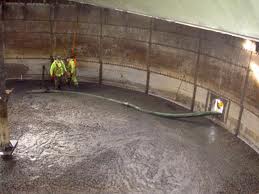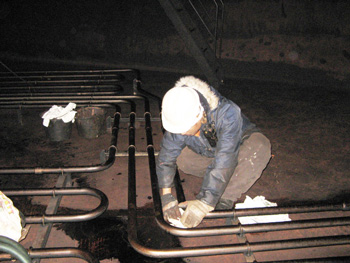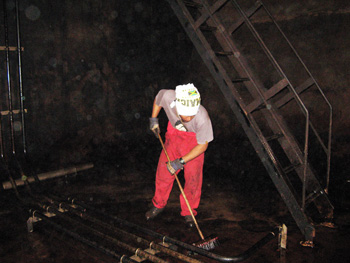
Viewing
Tank Cleaning Practice
11 Describe the pictures. What method and equipment for tank cleaning up do you see in pictures.
|
|
|
|
12 Watch the video and say if the statements are true or false. Correct the false once.
When tanks are to be inspected or maintenance must be performed within a tank, it must be not only cleaned, but made "gas-free."
The COW system is used to remove asphaltic deposits and wax.
Water washing systems uses rotating high-pressure water jets to spray cold water inside the tank.
After a tank is cleaned, the liquid is left in the tank and used as ballast water.
To free tank from hydrocarbons fresh air is blown into the tank.
After a tank is gas-free, "mucking" is generally done by able seamen and deck officers using tools such as mops, buckets, rags and sponges.
13 Read the text.
Think of the title and subtitles of the text.
Replace the images (
 /
/
 /
/
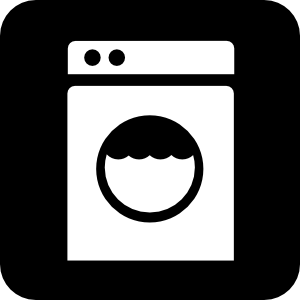 ) with word or word combinations from the box.
) with word or word combinations from the box.
crude oil , seawater, load on top |
__________________________________
1.________________________
washing (COW) is washing out the residue from the tanks of an oil tanker using the cargo itself, after the cargo tanks have been emptied. is pumped back and preheated in the slop tanks, then sprayed back via high pressure nozzles in the cargo tanks on to the walls of the tank. Due to the sticky nature of the , the oil clings to the tank walls, and such oil adds to the cargo 'remaining on board' (the ROB). By COWing the tanks, the amount of ROB is significantly reduced, and with the current high cost of oil, the financial savings are significant. MARPOL 73/78 made this mandatory equipment for oil tankers of 20,000 tons or greater deadweight.
2._____________________
Originally
oil tankers used one set of tanks for cargo and about one third of
the same tanks were for water ballast on their empty trips. High
pressure, hot,
![]() jets were used to clean the tanks and the mixture of
and residue called slops discharged into the sea, as was the
oil-contaminated ballast water. The 1954 OILPOL Convention attempted
to reduce the harm by prohibiting such discharges within 50 miles (80
km) of most land and 100 miles (160 km) of certain particularly
sensitive areas.
jets were used to clean the tanks and the mixture of
and residue called slops discharged into the sea, as was the
oil-contaminated ballast water. The 1954 OILPOL Convention attempted
to reduce the harm by prohibiting such discharges within 50 miles (80
km) of most land and 100 miles (160 km) of certain particularly
sensitive areas.
3______________________
The
discharges from
washing were still considered a problem and during the 1960s the
![]() approach began to be adopted. The mixture of cleaning water and
residue was pumped into a slop tank and allowed to separate into oil
and water during the journey. The water portion was then discharged,
leaving only
approach began to be adopted. The mixture of cleaning water and
residue was pumped into a slop tank and allowed to separate into oil
and water during the journey. The water portion was then discharged,
leaving only
![]() in
the slop tank. This was pumped into the main tanks and the new cargo
of it.
in
the slop tank. This was pumped into the main tanks and the new cargo
of it.
14 Watch the video again and answer the questions.
What types of tank cleaning operations do you know? What are their advantages/disadvantages?
What factors influence the necessary degree of cleanliness?
Why is it important to drain the tanks after cleaning?
In what cases do we need heat the cargo?
Why do we need to monitor tank’s atmosphere?
15 Solve the quiz
1 What International Code Flag is hoisted to denote loading of flammable liquid is going on?
a) Bravo c) Golf
b) Hotel d) Zebra
2 What is the first safety precaution observed in tankers before loading?
a) connect bonding cable
b) secure mooring lines
c) connect cargo hose
d) connect vapour line
3 Smoking is NOT permitted on the weather decks of tank vessels
a) when loading cargo through open hatches
b) except when water is being used to- control the decks
c) except when sand pails are provided and are filled
d) under any circumstances unless the vessel is gas free and is not alongside
4 To which place do tanker crew and visitors go to smoke cigarettes?
a) head c) cabin
b) mess hall d) authorized smoking area
5 When is cleaning by crude oil wash in the tankers done?
a) while discharging cargo
b) before drydocking
c) while at anchor
d) while at sea
6 Which one of the following is one major advantage of the load-on-top system?
a) cargo tanks corrosion is reduced
b) oil that was previously lost is recovered
c) discharge time is significantly reduced
d) no danger of contamination
7 What should be done with the oil residues left in the tank when the vessel is within a special area?
a) retain on board
b) discharge when 30 miles offshore
c) wait till darkness then discharge overboard
d) may be discharged anytime
8 What instrument is used to determine the depth of oil over the water in the slop tank?
a) interface detector c) cross bar
b) ullage tape d) sounding tape
9 What is the state of the tank or compartment that has been tested and found to be without toxic and explosive gases?
a) gas-tested c) aerated
b) gas-free d) fresh tank
10 What shall be continuously provided in an enclosed space with working crew?
a) water c) ventilation
b) watches d) equipment
11 What equipment is used when entering a compartment that is NOT gas-free?
a) life line
b) breathing apparatus
c) face mask
d) asbestos suit
12 What is the instrument that is used to measure concentrations of combustible gas and air mixture?
a) psychrometer c) explosimeter
b) gas meter d) oxymeter
13 What size of oil tankers is required to be built with double hulls as approved by IMO for oil pollution prevention?
a) over 30,000 DWT
b) over 5,000 DWT
c) over 20,000 DWT
d) over 10,000 DWT
14 If it becomes necessary to pump bilges while a vessel is in port, which of the following procedures should be followed?
a) Pump only if discharged is led to a shore tank or barge
b) Pump only during the houses of darkness
c) Pump only on the outgoing tide
d) Pump only as much as is necessary
15 When oil is accidentally discharged into the water, what should you do after reporting the discharge?
a) Prevent spreading and removes as much oil as possible from the water
b) Throw chemicals on the water to disperse the oil
c) Throw sand on the water to sink the oil
d) Request the coast guard to take care of cleaning up the oil
16 The oil record book is required to be carried aboard:
a) tanker
b) passenger vessels
c) cargo vessels
d) all of the above
17 Bilge soundings indicate
a) the amount of condensation in the hold
b) whether the cargo is leaking or not
c) whether the ship is taking on water
d) all of the above
18 When removing the cap from a sounding tube, the sound of air is escaping indicates that the tank
a. is full
b. may be partially flooded
c. level has dropped
d. is completely flooded

16 Tick the type of accident occurred on board.
-
fire
grounding
collision
capsizing
leakage
icing
Case story 1
5
April 2010 05:19 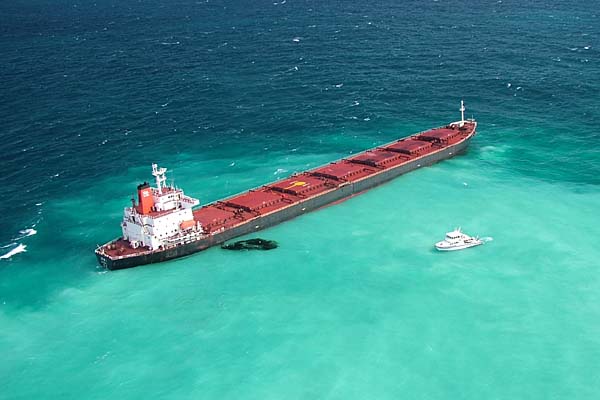
Chinese tanker Shen Neng 1 is in distress off the coast of Australia near the Great Barrier Reef, Great Keppel Island. It is reported that the ship ran aground. The crew remained on board, although there is a threat to flood the ship. To the scene came the Australian lift Marine Australian authorities are working on different options for a rescue operation for the removal of shoals bulker "Shen Neng 1", sitting on the rocks on the Great Barrier reef. It is estimated that nearly 2 tons of oil have appeared in water from the deck of the pipeline system.
Now rescuers are trying to stabilize the vessel. This involved the marine lift. That night should come second lift. Bulk carrier "Shen Neng 1" under the Chinese flag ran aground on the Great Barrier Reef on Saturday night. Since then, the ship shifted to 20-30 m, destroying coral in its path. The vessel is 975 tons of fuel oil and 65 thousand tons of coal. After the accident were seen oily stains. Australian authorities have expressed concern about the environmental situation in the region.
Oil spill poses a real threat to the environment. Currently, work began in the aftermath of the accident with the help of dispersants; allow collecting oil from the water surface. Rescuers working at the scene of work are also trying to fix the hole in the vessel. "This is a matter of weeks", - said the head of the Office of Marine Safety Queensland, Patrick Kverk.
Great Barrier Reef is the largest ecosystem in the world. This is a ridge of coral reefs and islands in the Coral Sea, which stretches along the north-eastern coast of Australia at 2300 km. In the northern part it is of the width of about 2 km, in the south - 150 km. Most of the reef is under water, showing at low tide.
Great Barrier Reef is also a marine national park included in UNESCO World Heritage List.
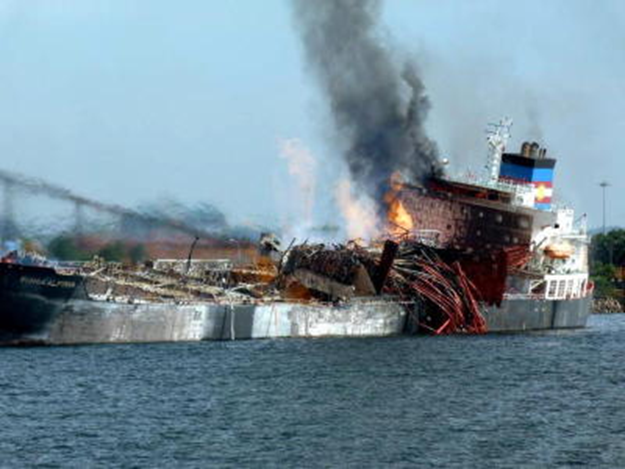
Case story 2
The MV Bunga Alpinia 3 sitting on a shallow seabed after firemen and maritime rescuers failed to pull it out from the wharf during the height of the fire at the Petronas methanol jetty at Pulau Enoe, Labuan.
The fire was brought under control at about 8pm yesterday but firefighters said they expected the flames would take a few more hours to be extinguished before they could board the tanker to search for the missing crewmen.
A charred body recovered from the jetty was identified as Shahril Azmi Baharudin, 28, from Malacca. The body has been sent to the Labuan nucleus hospital.
Labuan police Chief Supt Saiman Kasran confirmed that witnesses had reported the fire occuring during flashes of lightning. He said the 38,000DWT chemical tanker, 172.87m-long and 32m-wide, had a crew of 27, of whom 22 were working when the fire broke out.
Nineteen of them escaped with three suffering slight burns while the remaining five were seen jumping off the tanker when the explosions started. Malaysian Maritime Enforcement Agency Sabah chief First Admiral M.Karunathi said an attempt had been made to pull the ship out of the wharf with a tugboat but the cable burned. The tanker drifted about 20m and was “sitting on a shallow seabed”. Ship owners MISC Berhad said in a statement that the crew members comprised 23 Malaysians and six Filipinos. Labuan fire Chief Zainal Madasin said 71 firemen fought the blaze which destroyed nearly half of the ship.In PETALING JAYA, maritime technology experts say that lightning strikes or fires on ships carrying volatile cargo are rare.
Prof Omar Yaakob of Universiti Teknologi Malaysia said: “There have been two incidents in the country in the past five years where tanker ships being repaired in dockyards caught fire when flammable vapour from their tanks came into contact with sparks,” said Omar.
“But a tanker catching fire while in operation is almost unheard of as tankers are subject to much higher safety standards than normal ships.”
Another maritime safety expert said ships were equipped with onboard lightning arrestors to channel the current from any lightning strike into the sea.
17 Complete the table with the information.
|
Type of ship |
Type of cargo |
Accident happened |
Causes |
Actions taken |
Consequences |
Shen Neng 1 |
|
|
|
|
|
|
MV Bunga Alpinia 3 |
|
|
|
|
|
|
18 Discuss whether the accidents could be avoided.

